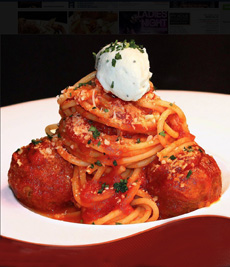FOOD FUN: Spaghetti & Meatball Sundae
|
For National Pasta Month try this “spaghetti sundae” inspired by a dish from VP3 Restaurant in Jersey City, New Jersey. RECIPE: SPAGHETT & MEATBALL SUNDAE Ingredients 1. COOK the spaghetti according to package directions and drain, reserving a few tablespoons of the pasta water. While the pasta cooks, heat the sauce and the meatballs. |

Spaghetti and meatball “sundae.” Photo courtesy VB3 Restaurant | Jersey City. |
|
|
2. RETURN the drained pasta to the pot and add the sauce. Mix to coat all the pasta with sauce. If the sauce is too thick, add the reserved pasta water, tablespoon by tablespoon, to reach the desired consistency. 3. MOLD the spaghetti into a tower. You can do this freehand with tongs and a large fork, or use whatever mold you have. We used a chinois (SHEEN-wah—French for “Chinese,” referring to the Chinese-style strainer). You can also try a large funnel, jumbo martini glass or a sundae dish. 4. ADD the meatballs, sprinkle with the grated cheese and top with the mozzarella ball. For a final touch, add the basil “sprinkles.” |
||
 We used a chinois to create the pasta tower. It’s actually a great kitchen tool for straining. Photo courtesy Fox Run. |
SPAGHETTI & LINGUINE: THE DIFFERENCE
The easiest way to differentiate them: Spaghetti is round, linguine (the proper Italian spelling–linguini is an incorrect Americanization) is flat. It is sometimes referred to as flat spaghetti. All pasta evolved regionally into different shapes and sizes. |
|
|
DIFFERENT MOZZARELLA SIZES
For the “cherry on the sundae,” you want a mozzarella ball, not a slice. Fortunately, mozzarella balls are made in several sizes, from perlini, the size of pearls, to bocconcini, large bites. They are sold fresh in water by Bel Gioso, Lioni and other companies. You can use any size with this recipe. We prefer the largest, bocconcini, because it will sit on the top of a mound of pasta, as in the photo at the top of the page. But even the smallest size, perlini, can be scattered around the base of the plate. From left to right: perlini, perle, nocciolini, ciliegini, bocconcini, ovoline, half pound, one pound. Image courtesy Lioni Mozzarella. Visit their website for a greater description of the different sizes of mozzarella.
|
||
